Tooth decay is a common issue found in both children and adults (via the Centers for Disease Control and Prevention). But how much do you really know about the cavity formation process and unhealthy habits that may contribute to this oral condition? As children, our parents, teachers, and dentists probably taught us the basics of oral hygiene. Revisiting this important health topic as an adult may shed new light on some surprising facts that may save your teeth, as well as your overall health.
The National Institute of Dental and Craniofacial Research points out that although tooth decay is on the decline in the U.S., 92% of adults between 20 and 64 have experienced cavities in their permanent teeth. Alarmingly, 26% of these adults have untreated caries.
How can a preventable condition create such staggering statistics? Fundamentally, our mouths, which are naturally full of microbes, are the perfect petri dish to grow harmful bacteria that leads to tooth decay (per NIH News in Health). According to Healthline, bacteria in the mouth — if not consistently cleared out through brushing and flossing — create plaque buildup on teeth that can lead to a breakdown of the affected tooth. When you eat and drink, the bacteria in your mouth creates acids that further erode the surface of your teeth (via The Journal of the American Dental Association). Thus, it is inevitable that tooth decay will occur unless you are diligent about your oral hygiene.
Tooth decay versus cavities
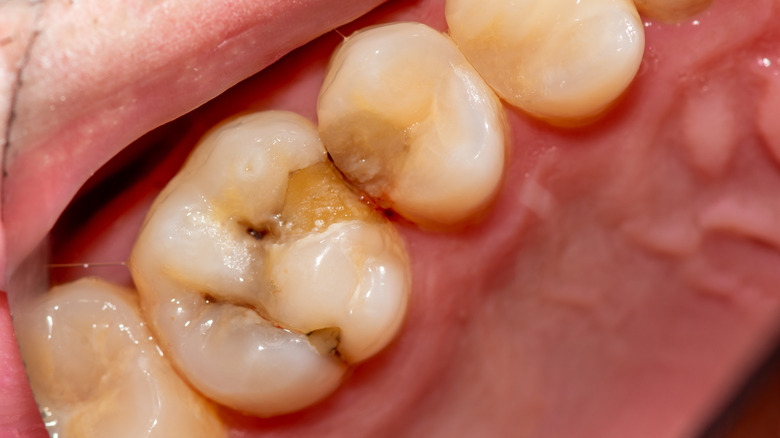
You may be wondering if tooth decay and cavities are the same. Although the terms tooth decay and cavity are often used interchangeably, their meanings are not necessarily identical. The American Dental Association (ADA)’s Mouth Healthy explains that tooth decay leads to cavities, but is not necessarily a cavity itself. Early erosion from decay may not be severe enough initially to disrupt the underlayers of a tooth (via Austin Prosthodontics). However, this “pre-cavity” condition will lead to caries if left untreated.
The Mayo Clinic describes cavities as permanent damage to the hard surface of a tooth, causing a pit to form where it has taken hold. With time, this hole will enlarge and progress deeper into the tooth, causing increased damage to the area.
The ADA warns that decay can also form around older permanent fillings and crowns as they crack and loosen with age, leading to cavity formation. Adults who did not grow up with regular access to fluoride are more at risk for this type of tooth decay.
Stages of tooth decay

Dentists tend to categorize tooth decay into five progressive stages. According to Healthline, the first stage of tooth decay is called “initial demineralization,” and simply shows up as a white spot on a tooth. At this juncture, the hard part of your tooth — the enamel — is not damaged, but it has lost a bit of important mineralization at the area of concern. You may be relieved to know that you can ward off a cavity during this first stage if you seek prompt intervention from a dentist.
During stage two, a brown spot and a hole in your tooth will give you a clue that an actual cavity is forming. Now it is too late for preventative measures, as permanent tooth damage has occurred. By the time a cavity reaches the third and fourth stages, your tooth will be sensitive and painful, as the pit has now reached the sensitive interior portion of your tooth. The damage has conquered the hard enamel surface and penetrated the soft inner layer called the dentin in the third stage, while in the fourth stage the problem has gone even further into the tooth, breaching the innermost pulp.
An abscess of the gums near the infected tooth signals tooth decay’s fifth and final stage. Now you have a medical emergency that needs dental intervention right away before the infection in your tooth spreads bacteria to your jaw and surrounding area.
Causes and risk factors for tooth decay

Viktoriia Hnatiuk/Shutterstock
Do you remember your parents’ constant reminders to brush your teeth every morning and night? How many of us rushed through that routine without a thought about the consequences of our less-than-stellar brushing technique? As an adult, you are most likely more aware that lax dental hygiene is the primary cause of tooth decay. Improper and irregular brushing and flossing play a significant role in tooth decay (per Healthgrades). In addition, high sugar consumption can lead to tooth decay.
Did you know that having a dry mouth can hurt your teeth? It turns out that we need plenty of saliva to maintain healthy teeth (via Healthgrades). Importantly, GoodRx points out that certain medications, such as those found in antihistamines, can dry out your mouth, leaving it more prone to bacterial growth due to less moisture to dilute and wash away the offending germs.
Healthgrades discloses that certain health conditions can also negatively affect your dental health. While high blood pressure, lung disease, rheumatoid arthritis, and diabetes have been linked to gum disease, osteoporosis and kidney disease can negatively impact bones and teeth. For unknown reasons, obesity is associated with a more severe type of gum disease called periodontitis.
Surprising contributors to tooth decay

Krasula/Shutterstock
Wekiva Dental notes that those who have not had the benefit of fluoridated water or fluoride tablets growing up may be more vulnerable to tooth decay, as this mineral is protective against tooth decay and cavities. Are you a nail biter, or do you grind your teeth at night? If so, these everyday habits may also lead to tooth decay by chipping and wearing down the protective enamel coating of your teeth. Or, do you have crooked or crowded teeth? Your smile may be a concern, as the lack of space between teeth makes effective brushing and flossing harder while providing an opportune place for bacteria to hide
Although many tout red wine in moderation for its potential health benefits, your teeth may tell you a different story. Colgate warns that an acidic diet, wine included, has been found to be a contributor to tooth decay. Foods that can damage your teeth are typically very acidic, sticky, and sweet.
Smoking is also a big risk factor for dental issues, as WebMD explains, because it causes impaired blood flow to the gums. The National Eating Disorders Association adds that poor nutrition from eating disorders and frequent vomiting from bulimia create an acidic environment in the mouth that erodes teeth, with the back molars especially at risk.
If you need help with an eating disorder, or know someone who is, help is available. Visit the National Eating Disorders Association website or contact NEDA’s Live Helpline at 1-800-931-2237. You can also receive 24/7 Crisis Support via text (send NEDA to 741-741).
How do you know if you have tooth decay?

Photoroyalty/Shutterstock
Having a painful cavity can disrupt the best of days. However, the beginnings of tooth decay may go unnoticed until you see your dentist for a check-up (via National Health Service). Early tooth decay is often painless, and there is no telltale black hole to clue you that there is a problem.
Gentle Dentistry advises you to be aware that the crevices between your teeth can hide tooth decay and caries. Unless a cavity in this area is causing pain or has gone untreated and has become significant, you may not even know that you have a dental concern brewing between your pearly whites.
Conversely, unlike the early stages of tooth decay, cavities are less sneaky and give obvious indicators of their presence. Aside from a sore tooth, what other symptoms point to advanced tooth decay and cavities? In addition to actually seeing a discolored spot on your tooth along with a pit or hole on its surface, you may begin to experience tooth sensitivity. When hot or cold foods create an uncomfortable feeling in a tooth, tooth decay or other oral issues are likely the main culprit (via Mouth Healthy).
Tooth decay in infants and children

Kaew LIVER/Shutterstock
Parents should be aware that although young children get a second chance for new teeth after their baby teeth fall out, tooth decay at any age can cause discomfort and dental complications in children. Therefore, dental check-ups and proper oral hygiene are just as crucial for children as adults.
Healthline points out that although the signs of tooth decay in children are the same as in adults, younger children may have difficulty recognizing and expressing dental issues. Therefore, watch out for excessive fussiness, mouth swelling, unwillingness to eat, or a sudden preference for softer foods.
Dental caries can begin at a very young age. You may have heard the phrase “baby bottle tooth decay” associated with toddlers who develop cavities as their newly formed teeth are just coming in (via Mouth Healthy). The problem has been attributed to using bottles to feed or pacify infants and toddlers with teeth. This is especially true in cases where the child has access to the bottle over a long period, such as overnight, and when the contents of the bottle are sugary (this includes milk, but also juice and other sugary drinks).
Preventing tooth decay in children

New Africa/Shutterstock
It is vital for young children to have strong, healthy teeth right from the start to develop proper speech, chew their food correctly, and have a confident smile (via Mouth Healthy). By providing solid guidance, supervision, and teaching about oral hygiene and healthy food choices, you can assist your child in making good choices regarding their teeth. Starting as soon as your child’s first tooth erupts, remove the bottle while in the crib or replace the contents with water, advises iCliniq. Additionally, wiping your little one’s gums and teeth daily with a clean wet cloth is essential to remove germs and prevent tooth decay.
The Pennsylvania Dental Association recommends regular dental check-ups beginning at age one. They also point to sugary drinks and candy, especially sticky selections such as gummy bears, as the main offenders that cause tooth decay in kids. The site instructs brushing twice daily with a pea-size dollop of fluoride toothpaste for kids starting at age 2.
Fluoride is a powerful weapon to combat tooth decay in children. In addition to fluoride toothpaste, the American Academy of Pediatrics (AAP) suggests fluoridated water for children. If this is not an option, discuss fluoride supplementation with your pediatrician or child’s dentist. AAP also recommends that a fluoridated varnish be applied per the recommended schedule to your child’s teeth to provide excellent protection from tooth decay. Ask your child’s doctor all about the benefits of these critical fluoride measures as soon as your child is born.
Tips to prevent cavities as an adult
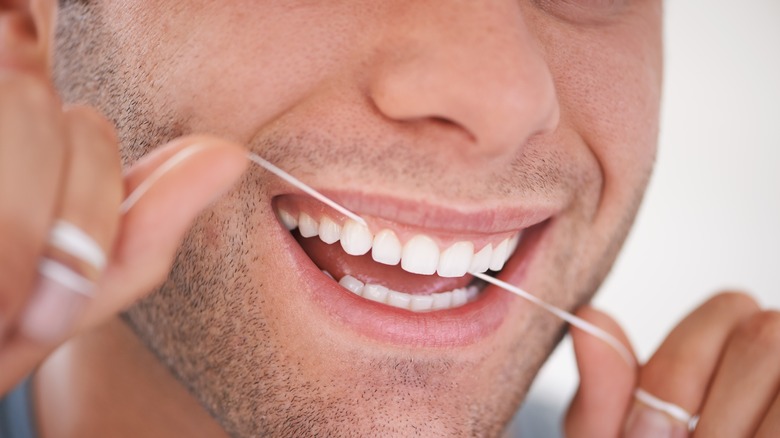
PeopleImages.com – Yuri A/Shutterstock
Frequent and proper tooth brushing is really the number one way to ward off caries. The ADA’s Mouth Healthy recommends brushing two times a day with fluoride toothpaste. Use a soft-bristled toothbrush that is small enough to reach into the back of your mouth and clean those hard to reach deepest molars. Move the toothbrush back and forth across your teeth using small strokes. As the bristles begin to fray (every three to four months), replace your old toothbrush with a fresh one to keep your teeth shiny and healthy.
Don’t forget about flossing. With food sticking in the tight spots between your teeth, flossing is a vital tool to remove bacteria, plaque, and particles that simple brushing misses. WebMD points out that although flossing may not be a popular task for many, you will be glad that you did in the long run. Fewer cavities and less time in the dental chair having plaque scraped away will be the payoff.
Regular dental check-ups and cleanings are a vital routine for optimal dental health (via Mouth Healthy). Dental visits help to keep your plaque under control, which can translate to fewer cavities. In addition, the dentist will x-ray your teeth to look for hidden decay and check your mouth and tongue for cancers and gum disease, according to Dentalcare.com.
Treatment options for tooth decay
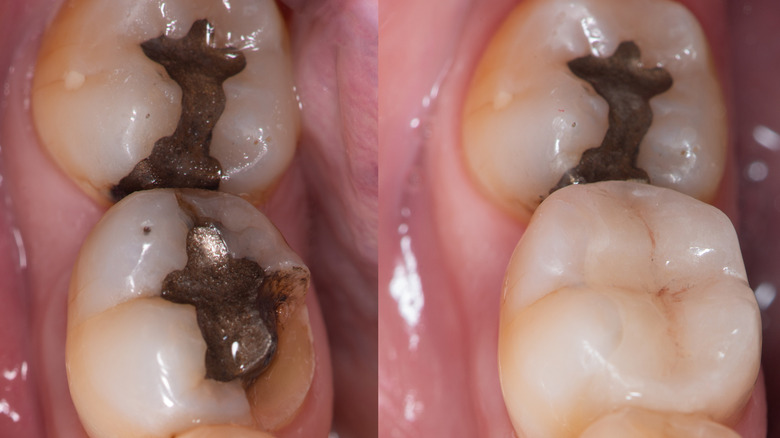
kksakultap/Shutterstock
Although some home remedies may temporarily help ease dental pain associated with tooth decay, only your dentist can permanently fix the underlying problem. According to Healthline, early tooth decay (stage one) can be reversed by halting the demineralizing process by applying fluoride directly to the affected tooth. This will help your tooth’s enamel to repair and strengthen
If that painless strategy doesn’t work and the decay becomes more advanced, the next step is typically a filling. Your dentist will scrape away the diseased portion of the tooth and then pack the newly made hole with one of several tooth-filling materials (via WebMD). If the cavity reaches your tooth’s inner portions — the dentin and the pulp — you may need a crown or root canal to save the tooth (per Healthline). A crown, according to WebMD, is placed over a tooth if the cavity is large, or if the tooth is crumbling or broken. If tooth decay reaches the point when an abscess forms, this signals infection and your dentist must work quickly to save the tooth (via Healthline). A root canal may do the trick, but often it is too late, and the tooth will need to be extracted.
When does a decayed tooth need to be extracted?
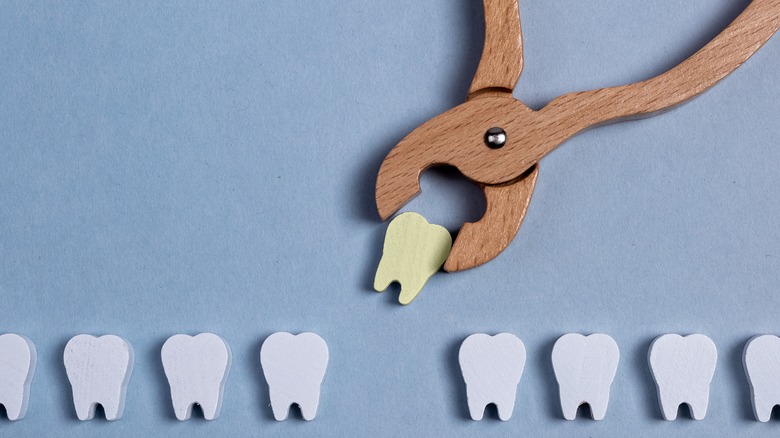
valiantsin suprunovich/Shutterstock
According to Colgate, decayed teeth that have become infected or are too deep for a filling may necessitate extraction. Mouth Healthy states that extraction is a last-ditch measure after your dentist has tried his best to save your tooth with a root canal.
Colgate points out that extractions are categorized as simple or surgical. If the tooth is above the gum line and can be removed by forceps, you should be a candidate for a simple extraction. This typically quick procedure is done in the dentist’s office.
If the tooth cannot be grasped firmly with forceps due to severe damage or decay, or if tissue or bone are obstructing access to the tooth, you will need a surgical extraction. For these more complex procedures, your dentist may direct you to an oral surgeon or periodontist. Though these procedures can sound intimidating, don’t worry. According to the Cleveland Clinic, there are numerous sedation options available to make you more comfortable during your tooth extraction.
When to see your dentist for tooth decay
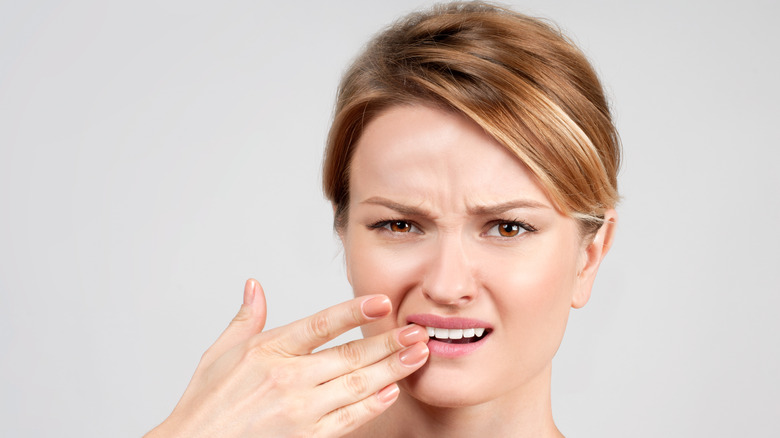
Dmytro Flisak/Shutterstock
Seeing your dentist regularly is a key measure to help prevent tooth decay from forming or advancing in the first place (via WebMD). For children, Colgate recommends regular dentist visits every six months following the appearance of their first tooth, or the child’s first birthday (whichever comes first). These checkups are key to help identify and treat tooth decay early, before it becomes a more significant problem. As an adult, AARP points out that annual dental check-ups are your best defense against tooth decay. Additionally, if you are at risk for dental issues due to certain conditions such as gum disease or diabetes, or you are a smoker, your dental provider may ask to see you more often.
Be aware of trouble signs that provide clues that you should promptly schedule a dental visit. Healthgrades stresses that tooth or jaw pain or injury are red flags, and you must consult your dentist promptly. Even tooth sensitivity warrants a discussion with your provider. Gum swelling and bleeding and any new or unusual mouth sores, lumps, or bumps need further investigation. Report any new onset of dry mouth due to medications, health conditions, or unknown reasons. It is key that you do not put off the call, as it is likely that your issue will continue to escalate, sometimes very quickly.
Complications of tooth decay

stockpexel/Shutterstock
Don’t be fooled into thinking that the condition of your pearly whites only affects your dental health. You may be surprised to know that the condition of your teeth can reveal surprising health conditions such as nutritional deficiencies, diabetes, osteoporosis, Alzheimer’s, HIV, and even certain types of cancer, according to the Mayo Clinic. Periodontitis in a pregnant mother is even associated with problems for her unborn child, including low birth weight and premature birth.
Did you know there is a connection between untreated tooth decay and heart disease? Research has shown that the bacteria and inflammation caused by poor dental hygiene may lead to heart attack or stroke (via Journal of General Internal Medicine).
Tooth decay left untreated can also contribute to gum disease and eating difficulties, leading to poor nutrition and, in children, possible impaired growth and development. News Medical Life Sciences cautions that chronic dental disease can ultimately lead to lost time from work and school, which can negatively impact income, relationships, and wellbeing.



